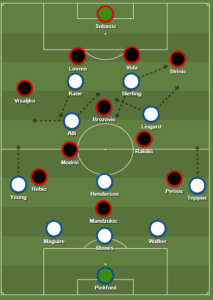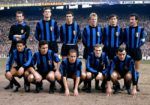This was a strange World Cup for the England national team and their fans. For the first time in a really long time, there was hope and excitement surrounding this team and there was genuine belief that Southgate can finally turn around things for England in a big tournament. Looking back at their campaign, England will certainly feel proud and hopeful as the core of this team is still young and most of the players will certainly improve by the time the next tournament comes around. But like Roy Keane pointed out, this was a huge opportunity for England to play in a World Cup final. Remember, this was the first ever World Cup not have either Brazil, Germany or Argentina in the semi-finals. England were handed a very easy group and in Colombia and Sweden, pretty easy opponents in the knockout stages. Even in the semis, Croatia were the weakest team they could face and in the first half it certainly looked like Football was coming home.
But as the second half started, it was clear that this was the “new” Southgate’s England we were seeing, it was the same old England who wilt under the first sign of pressure. Modric and Rakitic seized the midfield control and started spreading the ball wide. England’s left hand size was especially under heavy attack as the Croatian right back Šime Vrsaljko found himself repeatedly in huge amounts of space and peppered the box with pin-point crosses. On the attacking side, England was not able build from the back as they usually like do under Southgate as they were pressured by the Croatian forward at times joined by the excellent Luka Modric. So like all English side, they returned to their roots and lumped the ball forwards. With Harry Kane as the only genuine target, this tactic was bound not to work.

While it was clear that the English midfield comprised of Henderson and two number 10s in Alli and Lingard couldn’t match the Modric-Rakitic-Brozovic, for some strange reason Gareth Southgate couldn’t recognise the issue and the situation continued to extra time. We had written about this very issue earlier in Southgate’s 3-3-2-2 formation has some obvious flaws which can’t be ignored.
At first glance, England’s system seems to contain some species of a classic midfield triumvirate however, it is somewhat unconventional (read: very attacking) and perhaps not as midfieldy as it might appear. Neither Alli nor Lingard (the two behind the front two) are natural central midfielders. Neither are box-to-box players and neither are classic number 10s. It is hard to define their roles exactly but, at club level, Alli plays probably closest to a 9-and-a-half/second striker and Lingard usually as an inverted winger or, more recently, as a sort of false 10. Both are fundamentally attacking weapons and neither play as the deepest or even second deepest midfielder for their club team. Classifications aside, let’s call them: quite attacking midfielders. Crucially, in Southgate’s system, both of the them are encouraged to push very high up – as are their natural tendencies – and get very close to the front two of Kane and Sterling. As they push up in possession the result for the team is the formation of a frightening front four. It is very appetising for the viewer but it has its negative implications on the overall team shape and ultimately exposes what lies behind its speedy trail: the midfield.
The solution was for Southgate to either bring in another midfielder alongside Henderson and ask Alli and Lingard to mark the opposing full-backs or move Sterling to the left and specifically give him the task of marking Croatia’s right-back. He did neither. Even his substitutions were just like for like and didn’t change much until Vardy came on. Maybe tougher matches in the group stages might have forced Southgate into a rethink.
Going forward, England are certainly more exciting than any of their previous teams and this formation works really well against weak opposition. They have pace, guile and more importantly numbers when they attack. But against quality opposition, this formation is unbalanced and puts too much workload on the midfield three. It is important that Southgate and the players learn from this experience, but they may never get a better chance again to be in the World Cup final.









Recent Comments